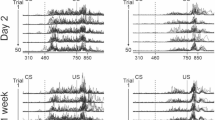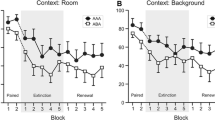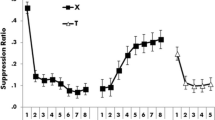Abstract
One purpose of the present experiments was to determine if the Grice and Hunter (1964) observation of augmented within-versus between-Ss CS intensity effects in human eyelid conditioning would be obtained in conditioning of the rabbit’s nictitating membrane response under two (Experiment 1) and four (Experiment 2) CS intensity values. In addition, a determination was made of the effects of CS intensity upon extinction and stimulus intensity generalization gradients. The studies revealed that: (a) while acquisition performance was positively related to CS intensity, the effect was independent of the between and within-S manipulation of CS intensity; (b) rate of response decrement in extinction was an inverse function of CS intensity; and (c) a positively sloped intensity generalization gradient was obtained when the training stimulus was the low-intensity one. Overall, these results are most consistent with Hull’s (1949) stimulus intensity dynamism account of CS intensity effects in conditioning.
Similar content being viewed by others
References
Anderson, N. H.: Comparison of different populations: Resistance to extinction and transfer.Psychol. Rev.,70:162–179, 1963.
Barnes, G. W.: Conditioned stimulus intensity and temporal factors in spaced-trial classical conditioning.J. Exp. Psychol.,51:192–198, 1956.
Carter, L. F.: Intensity of conditioned stimulus and rate of conditioning.J. Exp. Psychol.,28:481–490, 1941.
Frey, P. W.: Within- and between-session CS intensity performance effects in rabbit eyelid conditioning.Psychonom. Sci.,17:1–2, 1969.
Gormezano, I.: Classical conditioning.In J. B. Sidowski (Ed.)Experimental Methods and Instrumentation in Psychology. New York: McGraw-Hill, 1966.
Gormezano, I., Schneiderman, N., Deaux, E. B., and Fuentes, I.: Nictitating membrane: Classical conditioning and extinction in the albino rabbit.Science,138:33–34, 1962.
Grant, D. A., and Schneider, D. E.: Intensity of the conditioned stimulus and strength of conditioning. I. The conditioned eyelid response to light.J. Exp. Psychol.,38:690–696, 1948.
Grant, D. A., and Schneider, D. E. Intensity of the conditioned stimulus and strength of conditioning. II. The conditioned galvanic skin response to an auditory stimulus.J. Exp. Psychol.,39:35–40, 1949.
Grice, G. R.: Stimulus intensity and response evocation.Psychol. Rev.,75: 359–374, 1968.
Grice, G. R.: Conditioning and a decision theory of response evocation, in G. H. Bower (Ed.)Psychology of Learning and Motivation. Vol. 5. New York: Academic Press, 1972.
Grice, G. R., and Hunter, J. J.: Stimulus intensity effects depend upon the type of experimental design.Psychol Rev.,71:247–256, 1964.
Hovland, C. I.: The generalization of conditioned responses: II. The sensory generalization of conditioned responses with varying intensities of tone.J. Genet. Psychol.,51:279–291, 1937.
Hull, C. L.:Principles of behavior. New York: Appleton-Century-Crofts, 1943.
Hull, C. L.: Stimulus intensity dynamism (V) and stimulus generalization.Psychol. Rev.,56:67–76, 1949.
Hull, C. L.:A behavior system. New Haven: Yale University Press, 1952.
Kamin, L. J.: Temporal and intensity characteristics of the conditioned stimulus.In W. F. Prokasy (Ed.)Classical Conditioning: A Symposium. New York: Appleton-Century-Crofts, 1965.
Kupalov, P. S., and Gantt, W. H. The relationship between the strength of the conditioned stimulus and the size of the resulting conditioned reflex.Brain,50:44–52, 1927.
Lipkin, S. G., and Moore, J. W.: Eyelid trace conditioning, CS intensity, CS-UCS interval, and a correction for “spontaneous” blinking.J. Exp. Psychol.,72:216–220, 1966.
Logan, F. A.: A note on stimulus intensity dynamism (V).Psychol. Rev.,63:63–73, 1956.
Mattson, M., and Moore, J. W.: Intertriai responding and CS intensity on classical eyelid conditioning.J. Exp. Psychol.,68:396–401, 1964.
Pavlov, I. P.:Conditioned reflexes. (Translated by G. V. Anrep). London: Oxford University Press, 1927.
Perkins, C. C., Jr.: The relation between conditioned stimulus intensity and response strength.J. Exp. Psychol.,46:225–231, 1953.
Razran, G.: The dominance-contiguity theory of the acquisition of classical conditioning.Psychol. Bull.,54:1–46, 1957.
Author information
Authors and Affiliations
Additional information
This research was supported by Grant GB-7907X from the National Science Foundation.
Rights and permissions
About this article
Cite this article
Scavio, M.J., Gormezano, I. CS Intensity effects on rabbit nictitating membrane conditioning, extinction and generalization. Pav. J. Biol. Sci. 9, 25–34 (1974). https://doi.org/10.1007/BF03000500
Issue Date:
DOI: https://doi.org/10.1007/BF03000500




